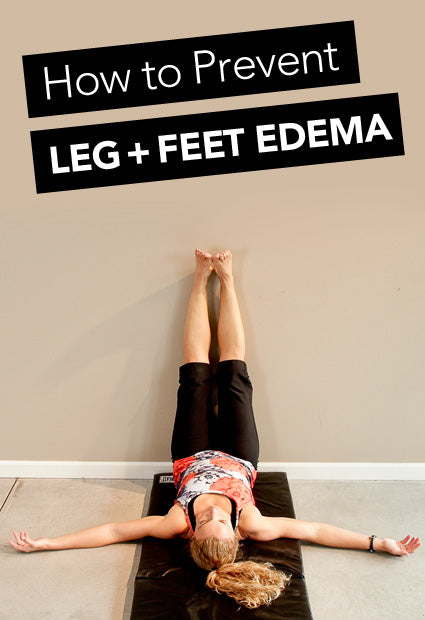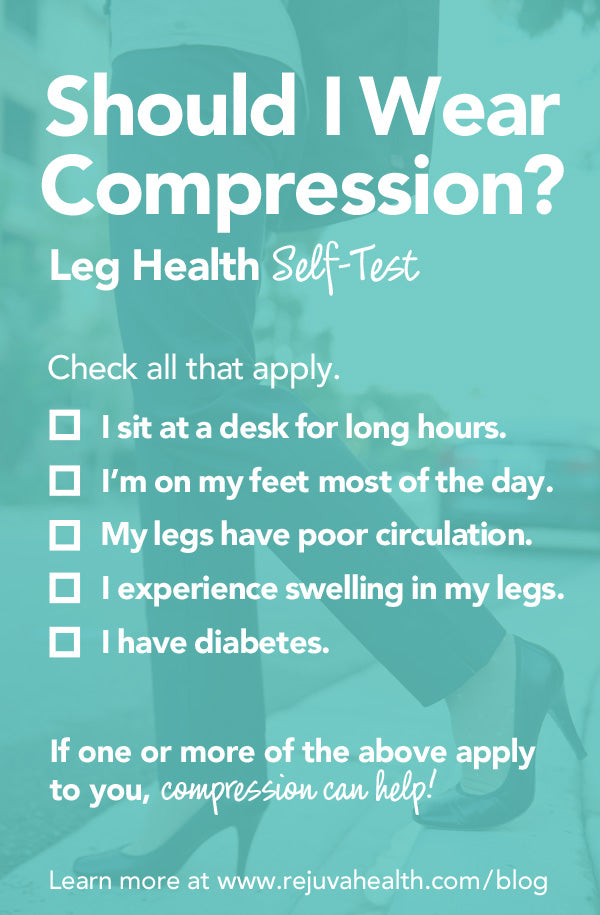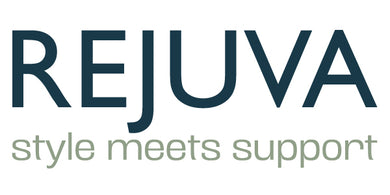
Simply Sore or Something More? 4 Conditions Affecting Leg Health
Have you ever noticed your shoes fitting more tightly if slipped on later in the day? Or looked at your legs in the mirror and done this?

Sometimes your gams simply may not look or feel as good as you want. A salty dinner, prolonged sitting, a long day on your feet ... occasional tweaks to diet or route can leave you feeling temporarily puffy or sore. But if it happens often, it may also be the sign of a larger medical problem. If your legs fall into the "repeat offender" category, keep reading. We’ve rounded up some of the more common causes of leg swelling & pain, as well as tips and treatment info, to help you get informed.
1. TIRED, ACHING LEGS Quick Facts
- What happens - Legs feel sore after long periods of either sitting or standing.
- Worsened by – a sedentary lifestyle, long periods of sitting or standing, age, diet, smoking, obesity
- Improved with - exercise, diet improvements, not smoking, graduated compression stockings

The Full Scoop
Do you sit or stand for long periods of time and find that your legs hurt or feel extremely sore? You may have tired, aching legs syndrome. You’re not alone though – over 60% of adults regularly experience leg aches, and for many of them the pain is so intense that it interferes with their daily lives. The root of the issue is poor leg circulation. These aches occur as a result of your body’s constant fight to push blood up to the heart while sitting or standing. Normally your lower muscles help force the blood upwards by squeezing your veins, but if you don’t change position there’s not much you can do.
Luckily, as long as your leg aches aren’t the result of an underlying condition (consult your physician if you’re worried), there are some simple solutions. The first is to punctuate your day with small 5-10 minute breaks. If you’re standing, rest your legs for a bit. If you’re sitting, take a short walk around the office or peddle your legs in your chair like you’re riding a bicycle. The second is to wear compression stockings. Graduated compression legwear is tight at your feet and ankles and looser as you move up, which helps squeeze the blood upwards throughout the day. If the pain is almost unbearable, rinsing your legs in cold water can provide you some relief by causing the vessels to shrink and pulling the blood into your core. Maintaining a diet that is balanced and low in saturated fats can also help to ensure your vessels remain unblocked and elastic. Try your best to keep cholesterol at a low, but don’t completely cut it out – in small amounts it helps your body deal with changes in temperature.
2. VARICOSE VEINS
Quick Facts
- What happens - swollen veins, often in the legs which cause pain and discomfort
- Worsened by - age, sex height, pregnancy, standing for long periods of time
- Improved with - sclerotherapy, varicose vein lotions, graduated compression stockings

The Full Scoop
It’s amazing just how prevalent venous disease is – in fact, it affects approximately half of the U.S. population. The root of this problem lies in the valves within leg veins. These tiny but powerful mechanisms operate one-directionally; opening to let blood through & closing as blood pumps upward towards the heart. When standing for long periods of time, prolonged pumping against gravity can begin to impair the valve's functionality causing blood to pool in the lower extremities & veins to stretch and become enlarged. When this happens, the valves relax and can’t completely close. The heart has to work harder to circulate the blood in one direction…and more blood continues to collect. It’s a vicious cycle! This venous insufficiency (weakened valves) often results in bulging, twisted veins in the legs, also called varicose veins.
Circulating blood becomes even more difficult during pregnancy because there is twice the amount of blood in your body. We’ve even heard stories of pregnant women with varicose veins all they way to their abdomens. Chronic venous insufficiency, in which the valves are damaged or dysfunctional, usually follows deep vein thrombosis and other related conditions. Most of the time, varicose veins are reversible only with a visit to the doctor’s office. The most well known medical procedure is sclerotherapy, in which the doctor injects a salt solution into your varicose veins. The salt solution aggravates the lining of the blood vessels causing the walls to stick together and the blood to clot. This blocks off the vessel and the scar tissue eventually fades away. The side effects, which include minor itching for a couple of days and some bumpiness of the skin, are mild and fade away within 3-6 months.
An interesting alternative to this sclerotherapy is varicose vein lotion that includes herbal extracts like horse chestnut seed or witch hazel. However, there is a bit of controversy surrounding these products – do they actually work? Studies have shown that the horse chestnut seed extract works, but many customers who use lotions with the substance have noted that while they have seen the appearance of their skin improve, it wasn’t a big difference and especially did not work well on the larger veins. If you’re more inclined to use a simple and foolproof approach, compression hosiery offers a great alternative. They force the vessels to shrink and valves to close, promoting healthy, unidirectional blood flow as well as pain reduction. Compression stockings, while they work therapeutically, are also a great aid in preventing varicose veins before they occur. A healthy diet and regular exercise is also essential for maintaining unblocked and elastic veins throughout life.
3. EDEMA
Quick Facts
- What happens - swelling
- Wornsened by - long periods of standing, physical inactivity, pregnancy, high altitudes, heat
- Improved with - hydration, low-sodium diet, graduated compression stockings

The Full Scoop
How do we define edema? Well, it’s just a fancy word for swelling that takes place in the body. This swelling can occur for different reasons – allergic reactions, fracturing bones, eating lots of salty food, etc. Swelling that occurs in your limbs is known specifically as peripheral edema, and occurs in places like your arms, hands, but most commonly in the legs and feet. The severity of the swelling can vary depending on location. The lymphatic system in your body controls and drains non-blood fluid called lymph, which normally bathes your tissues to keep them healthy and rich with nutrients. In edema, the lymph builds up because it isn’t drained quickly enough…which can transform your ankles into CANKLES.

Because the lymphatic system works in tandem with your blood’s movement, poor circulation often causes edema. For this reason (just as in leg aches and varicose veins), staying in the same position for long periods of time or being pregnant can make lymph pool in the ankles and feet. Swollen feet can also occur at high altitudes or on a hot day. Because your muscles naturally help move fluids in the body, being physically inactive can compound the effects of a slow-moving lymphatic system. A regular exercise regimen can work to strengthen muscles & improve the efficiency of fluid movement.
Diets that are high in sodium and low in water often lead to more swelling and fluid buildup. When you eat lots of salt, your body tries to retain as much water as it can to compensate. This can lead to problems like ankle swelling, bloating and puffy eyes. (TIP: Never eat ramen before picture day!) By constantly drinking water, your body can flush out excess salt and maintain healthy lymph. A diet that is full of vegetables with high water-content like cucumbers, spinach, and sweet peppers can also help you get hydrated without taking out a glass. In conjunction with a good diet and exercise, support stockings offer leg massages to promote fluid movement, which helps deal with amassed lymph and prevent the buildup from happening again. Looking cute while cutting down leg swelling? Yes, please.
4. DIABETES
Quick Facts
- What happens - Veins harden and blood pools in lower legs
- Worsened by - physical inactivity, high-sugar diets, smoking
- Improved with - regular exercise, avoiding sugars

The Full Scoop
Diabetes mellitus is a disease in which the body has trouble processing sugars. One of the effects of diabetes is the hardening of veins and arteries, including in the legs. Because of this, the veins lose your elastic quality and struggle to push blood back to the heart. The veins can become partially or completely blocked, resulting in a higher likelihood of blood pooling and blood clots. Diabetes and deep vein thrombosis are closely related. Yikes! Hardening occurs faster when combine with physical inactivity and smoking. Both Type 1 (genetic) and Type 2 (acquired) diabetes patients experience this discomfort in their legs, and this can be alleviated with – you guessed it – compression stockings. They will do some of the work in forcing the blood through your hardened veins and arteries. Another way to reduce pooling of the blood is to elevate the feet to a height above your head while you’re sleeping to lessen the resistance of the fluid going from leg to heart. Lastly, since Type 2 diabetes is preventable, having a diet that has a low glycemic index (which basically means it doesn’t affect blood glucose levels) will greatly increase your chances for better health and happiness later in life.
Some great superfoods for diabetics include kale, whole grains, berries, and sweet potatoes. A delicious and diabetic-friendly Mediterranean lunch is hummus, turkey, tomatoes, cucumbers, low-fat feta, and olives rolled up in a whole-grain wrap! The common remedy across all of the above conditions? You may have noticed … 1) a healthy diet, 2) regular exercise, and 3) compression legwear …. All contribute to the prevention of many health issues. Whether seeking to stop swelling, avoid achiness, combat diabetes, or fight unsightly veins, proactively incorporating these three things into your daily life can maintain a healthy heart and blood vessel system. Still unsure whether leg health is something that should be of concern to you? Try this brief self-test. If you check “YES” to any of the below, compression may help.

